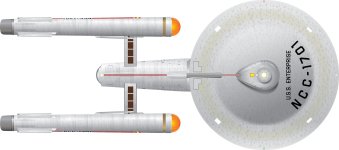If the board can sustain the inrush current, superb! (I don't like double boards either) My thought was simplistic: Never underestimate Mark, so if bigger buggers can't be on the board, then they maybe aren't supposed to be onboard (by design)...rather not build one delay board per channel though I have considered this.
@RickRay "to boldly go where …"
Attachments
Assuming that there is space in chassis and sufficient clearance to avoid EM pickup by signal wires, then I would do two boards for my own design.
Divides load between two boards, thereby reducing any concerns with copper trace handling and current limits, adapting and placing oversized current limiters, and arguably makes dual mono PS construction and troubleshooting easier. But I will admit these are simply preferences snd not hard limits requiring use of two boards; plus there is extra cost if boards, parts , and the space need (as mentioned above). In 4U Deluxe chassis, this may preclude use of double boards.
Divides load between two boards, thereby reducing any concerns with copper trace handling and current limits, adapting and placing oversized current limiters, and arguably makes dual mono PS construction and troubleshooting easier. But I will admit these are simply preferences snd not hard limits requiring use of two boards; plus there is extra cost if boards, parts , and the space need (as mentioned above). In 4U Deluxe chassis, this may preclude use of double boards.
I am not sure why there is the concern about copper traces.
My impression is that this circuit reduces high inrush current. Increasing the size of the CL is surely just going to slow the rate at which it heats up, therefore maintaining more modest `charge up' currents for longer. Using a 2Sec time delay and a big CL should enable a higher value of charge to be put into the smoothing capacitors while maintaining realistic values for current.
I can appreciate there is some question of how one solders the welding rod legs to the board without lifting the tracks -so going for two in series may be more realistic from a practical standpoint.
Maybe I'm missing something here.
My impression is that this circuit reduces high inrush current. Increasing the size of the CL is surely just going to slow the rate at which it heats up, therefore maintaining more modest `charge up' currents for longer. Using a 2Sec time delay and a big CL should enable a higher value of charge to be put into the smoothing capacitors while maintaining realistic values for current.
I can appreciate there is some question of how one solders the welding rod legs to the board without lifting the tracks -so going for two in series may be more realistic from a practical standpoint.
Maybe I'm missing something here.
A simplified procedure to calculate an approximate value for the peak inrush current, could look like this:
Plug in the numbers for your design and voila! You get a conservative over-estimate of peak inrush current. In reality the current will be smaller because those other resistances in the mains circuit aren't zero.
The mains current obeys Ohm's Law, even at turn-on: current = voltage / resistance. Voltage in this case is Vmains (115VAC or 230VAC) and resistance is the total of all the series circuit elements.
Making the ultra conservative assumption that the transformer core is fully saturated at the instant of turn-on, its resistance is reduced to R_primary_copper. Then
Total Resistance Seen By Mains = MainsFuseR + (IEC RFI suppressor R) + (R of chassis wiring) + (Trafo_primary_copper_R) + (ICL_resistance_when_cold)
Now, making another conservative assumption, let's pretend that all terms in the above summation are ZERO microhms, except (ICL_resistance_when_cold). We pretend all other resistances are negligibly small compared to the ICL cold resistance.
Ohm's Law tells us: current = voltage / resistance and in this case: Inrush_current <= Vmains / (ICL_resistance_when_cold)
Plug in the numbers for your design and voila! You get a conservative over-estimate of peak inrush current. In reality the current will be smaller because those other resistances in the mains circuit aren't zero.
assuming transient music is short lived and will not cause overheating we're talking about the sum of bias/idle currents... I think it's a couple of amps so should be OK
but you have all sorts of interesting amps in your signature... so in your experience is that accurate?
but you have all sorts of interesting amps in your signature... so in your experience is that accurate?
- Home
- Amplifiers
- Power Supplies
- PCB: low voltage On-Off switch drives AC mains relay \ includes soft start .. H9KPXG
